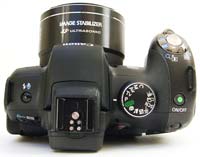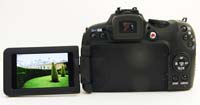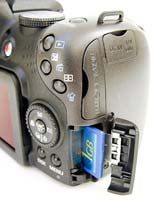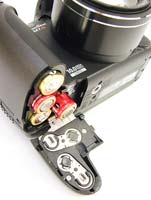Canon PowerShot SX1 IS Review
Review Date: January 14th 2009
Author: Gavin Stoker
Leave a comment about this review
|
Introduction
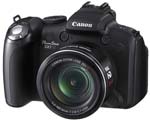
The Canon PowerShot SX1 IS camera is the second 20x super-zoom model from the Japanese giant, and the big brother of the SX10 IS that we reviewed at the end of 2008. Offering a lens equivalent to a massive 28-560mm focal length, Canon have included image stabilisation to help ensure that the majority of your shots are sharp, plus Ultrasonic Motor (USM) and Voice Coil Motor (VCM) technologies that promise fast, accurate and quiet zooming and focusing. The 10 megapixel PowerShot SX1 IS also features Canon’s new DIGIC 4 processor, full manual control over both aperture and shutter speed and an electronic viewfinder. Key differences from the SX10 IS include a larger 2.7" LCD screen, faster 4fps continuous shooting, a CMOS sensor (instead of CCD) and most notably the ability to shoot full 1080p HD video (1920x1080 pixels at 30 frames per second). Priced at £529 / €679.99, Gavin Stoker discovered if the Canon PowerShot SX1 IS is worth the substantial price-premium of £160 / €210 when compared with the SX10 IS.
Compare Prices
Support PhotographyBLOG: Buy the Canon Powershot SX1 IS from one of our affiliate retailers:Ease of Use
With sales of point and shoot digital compacts fairly flat in the UK at the time of writing, Canon has been turning its attention to expanding its 'superzoom' range of bridge models in recent months, one of the camera varieties that, along with DSLRs, still appears to be shifting units. The PowerShot SX1 IS joins the recently reviewed SX10 IS at the head of the charge, and like it forms a joint replacement for the earlier S5 IS model. There's a distinct sense of déjà vu here, as, near identically to its not-so-little brother, the chunky DSLR-styled SX1 IS also features 10 megapixels, a lens shift stabilized 20x optical zoom starting at a wide angle 28mm, but brings HD video clips (and a Full HD 1080p at that) to the table. With a manufacturer's UK asking price of around £529, it's far from cheap however, some £160 more than the SX10 IS and exceeding the price of many entry level digital SLRs bundled with a kit lens. So what have we got on board the SX1 IS that makes it worth, if not quite a king's ransom, then a pauper's ruin?
Well, like Canon's EOS DSLR range, the PowerShot SX1 IS features a CMOS sensor as opposed to regular CCD at its heart, which is a first for any of its compacts, enabling, along with a Digic 4 processor, the camera to shoot full resolution JPEGS at up to four frames per second, plus those High Definition movies. OK, while that frame rate's no match for a CMOS-sporting semi-pro DSLR in Canon's EOS range, nor sounds quite as impressive coming after Casio's 60fps EX-F1 or 40fps EX-FH20 bridge models (albeit achievable via a resolution drop), it's faster than most of us would arguably need from such a 'jack of all trades' device.
From the front however the Canon PowerShot SX1 IS gives few clues as to why it's worth the additional expense, being nigh the doppelganger for the previously reviewed SX10 IS model. It's big and tough looking, the only immediately discernable difference is the silver grey colouring of the chunky grip has been swapped for a more uniform black, whereby it better blends into the curves of the rest of the bodywork. As with the SX10 IS, the SX1 IS' larger than average grip is partly due to the four alkaline AAs required for power slotting into its base, which help lend the mainly plastic build camera its solid feel. They also mean however that the SX1 IS isn't in any way a pocket camera – you'll need to attach the provided shoulder strap or take a bag with you if you're heading out shooting.
As we complained when reviewing the SX10 IS, there's no full hard copy manual provided in the SX1 IS' box – though there is a lens hood and remote – just the typically rudimentary 'getting started' pamphlet, with the full manual alternatively provided on CD. While the latter is fine if you've a PC to hand, when you're outside shooting and can't track down the setting you want, not having a manual to hand to quickly flick through is a hindrance. And not everything about the SX1 IS proves immediately obvious. For example, for a camera that – following the ethos of the PowerShot range – should be fully featured yet intuitive to use, it's not readily apparent how 30fps HD movies are accessed. Turn the shooting mode dial to video and press the function button to select the resolution and, in head scratching fashion, you're offered just standard 640x480 or 320x240 pixel clips.
On the plus side, like the SX10IS, this flagship superzoom features a pair of stereo microphones sitting directly above the lens, which means stereo sound to accompany those videos. Given their location, thankfully (and necessarily) operation of the gargantuan zoom is near silent, thanks to Canon's pairing of an Ultrasonic Motor (USM) with Voice Coil Motor (VCM) technology, also included on the SX10 IS. The zoom lens is also equipped with optical image stabilization, enabling in our experience crisp and clear results when shooting handheld at maximum telephoto if there's plenty of light around.
So with the above overview in mind, let's take a tour of the Canon PowerShot SX1 IS pointing out the similarities and differences from the previously released yet announced-in-tandem SX10 IS. Inevitably we'll be covering some of the same ground, but bear with us…
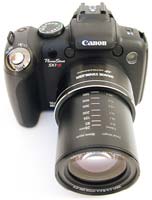 |
 |
| Front | Rear |
Examining the key features first, at the top of the camera we find a hotshoe for accessory flash from Canon's Speedlite series, also a feature of the SX10 IS, plus a useful flip out and twist LCD screen at the rear for those creative/awkward angle shots, here 2.8-inches rather than 2.5-inches in size, and newly elongated to widescreen dimensions. A night display mode enhances low light visibility. On the right hand side of the camera, if viewed from the rear, we find one of the other few differences over the SX10 IS; a covered HDMI port for connecting the camera up to a High Definition TV, though the cable you'll need to do so is (inevitably) an additional purchase. As with its baby brother, a dedicated button at the rear activates the video feature whichever shooting mode you're in. Marked by a red dot that universally signifies a record button, this naturally falls under the user's thumb at the rear of the camera.
Looking down on the Canon PowerShot SX1 IS with the back facing us, we are presented with the same fairly busy smattering of large buttons and dials as found on the SX10 IS. These run in an L-shape provided by the forward protrusion of the grip, and range from a dual purpose flash and voice memo button at the far left (that if held down on start up mutes the camera's operational sounds), across the familiar DSLR-like hump housing electronic viewfinder, built in flash and hotshoe, to a shooting dial at the other side featuring no less than 13 user selectable modes. Again the creative choice for S1 IS users here is the same as on the SX10 IS: full auto, program, shutter priority, aperture priority and manual, plus a user-attributable custom setting. Joining them are a selection of hand-holding pre-optimised settings for shooting portraits, landscapes, night snapshot, sports mode, plus a grouped selection of scene modes, including the familiar likes of a dedicated fireworks and sunsets settings, plus a stitch assist mode to help with shooting a sequence of shots for compositing together later as a single panorama. The final mode on the dial is, once again, for capturing movie clips.
As with its forebear, as you twist the physical dial a virtual version appears in the top right hand corner of the LCD screen if it's in operation, or in the EVF above if it's not, so you don't need to take your eyes off the subject. Like the SX10 IS, the 'traction' of the mode dial itself is a little loose, as it's easy to slip unnoticed from one setting to the other when retrieving the camera from a bag or during general handling. Adjacent to the shooting mode dial is a recessed but prominent on/off button that glows a comforting orange when the camera is activated, and on the forward slope of the grip itself we find a main shutter release button encircled by a rocker switch for moving through the broad zoom range (28-560mm equivalent).
Press the power button and SX1 IS proves as responsive as expected, taking just over a second for the zoom barrel to extend to maximum wideangle setting while the rear LCD or EVF bursts into life for composing the image in just over a second. Unlike rival cameras, there's once again no obvious dedicated EVF/LCD button for switching between the two options, this task falling instead to a press of the display button. If the user prefers, the camera can be set up so if the LCD screen is facing into the body upon power up, the EVF automatically bursts into life. Alternatively, if the screen is already facing out at the user, then it provides the method of shot composition. As you'd expect from an enthusiast model, shutter delay is imperceptible, yet committing a full resolution JPEG to memory took around two to three seconds; that's longer than the second or so it took on the SX10 IS.
Again, a press of the function button at the rear of the camera brings up a familiar L-shaped menu on the Canon PowerShot SX1 IS' screen, from which users can select from Superfine, fine or normal compression levels and a pixel count that varies from the full 10 million down to an email friendly VGA-quality, 640x480 pixels. Once again there's no RAW or TIFF shooting options offered here, which may be a black mark for some, and are perhaps a more serious omission given that, whopping lens range aside, the camera costs more than DSLRs with such features as standard.
|
Sound-tracked by a low mechanical whirr the zoom is very responsive, so much so that determining an exact point in its range can be tricky, though, unusually, markings detailing incremental steps throughout its range (both digital and, usefully, 35mm equivalent) are etched onto the top of the lens barrel. For improved accuracy, users can tab through these in baby steps with a gentle nudge of the lever. As indicated on the lens barrel, that Ultra Sonic Motor (USM) ensures your zoom transitions are commendably smooth. Given the SX1 IS' baby DSLR-like bulk, gripping it with both hands when shooting handheld feels necessary, not only to aid comfort but help prevent any instances of camera shake. Fortunately there is just enough of a ridge to the left, when viewing the camera from the rear, and at the back by the hinge for the LCD, for the user to do so without inadvertently smearing the screen with thumbprints.
Examining the back of the Canon PowerShot SX1 IS in more detail, top left of the LCD we find a direct print button that will be familiar to users of the Canon PowerShot range. However, unlike the SX10 IS that doubled up the use of this key in shooting mode as a user assignable short cut to the likes of red eye reduction or auto exposure lock, here the SX1 IS adds a second button alongside that changes the ratio of the image displayed on the LCD (or EVF) from regular 4:3 aspect ratio to widescreen. In reality you don't gain any more of the image at the sides however; the visual trick is simply performed by cropping into the image. Once you've performed this crop you suddenly and automatically have access to that full HD 1920x1080p video that was missing from the obvious menu line up earlier. Therefore Canon's own labeling could certainly be improved where this is concerned.
Adjacent to this button we have the rubber eye relief for the electronic viewfinder, just set back from a partly recessed dioptric adjustment wheel, while on the right hand side of the EVF we find aforementioned record button for shooting video clips. Luckily, the full extent of the optical zoom can be deployed when filming, and coupled with the stereo sound, this means that, while no match for a dedicated camcorder, video clips look better than expected when compared alongside clips from your average compact (view our provided video samples to decide for yourself).
Top right of the camera back are a trio of buttons set into the back, where they fall immediately under the thumb as your forefingers snake around the grip to the front. These serve the same purpose as those found in an identical position on the cheaper SX10 IS. The top one is self evidently marked for image playback, its positioning meaning you can quickly check the results of a capture while your finger remains hovering over the shutter release button for the next possible shot. A press of the next one down brings up an exposure compensation slider (+/- 2EV), or, if alternatively the user is still in playback mode, allows a sequence of images to be 'jumped' to find the one you're looking for more rapidly in this age of ever larger card capacities, search criteria determined either by a number of images, categories or folders. The bottom and last of the three small buttons is for deleting images when in playback mode, or, if in capture mode, lets the user move the otherwise central AF point to another portion of the screen. This is effected in conjunction with the four-way control pad with central 'function set' button and fiddly scroll wheel that we've criticized in the past and which encircles it just below.
Located at the four axis points around this pad are, at 12 o'clock, a means of determining manual focus. Press this and you're once again presented with a distance slider on the right hand side of the screen and an enlarged central portion of the image so focus can be more accurately determined. The very sensitive scroll wheel is used for moving through the available range, so a lightness of touch is required in operation. Moving to three o'clock on the dial we have a setting for adjusting ISO – here a manually adjustable range that moves incrementally up from ISO80 through ISO1600 – while at six o'clock is a means of switching from single to continuous shooting, choosing one of the available self timer options or wireless delay via use of the provided remote. Moving around to nine o'clock we find a close up mode – with either macro or super macro settings possible.
|
Press the function/set button at its centre when in any of the capture modes, and, as on the SX10 IS the aforementioned L-shaped toolbar that will be familiar to Canon users appears on the screen, offering pull out toolbars with further options from the range when you come to rest on a particular setting. In auto mode, only resolution/image size for stills and video is highlighted from the range, whereas if you move into one of the more creative PASM modes and press the button again, you can choose from any of the now fully accessible options. These include being able to adjust white balance, select from the familiar Canon 'My colors' modes – of which we preferred the 'vivid' setting for added visual punch (here there's the further option to individually bias vivid red, green or blue) – the chance to bracket exposures or focus, tweak the intensity of the flash, plus switch between evaluative, centre weighted and spot metering. Again this is the exact same range of options offered for the SX1 IS as on the SX 10 IS. Beneath this control pad and wheel are two more familiarly marked buttons, this time for image display ('disp') and menu. With subsequent presses the former turns the display on off, or calls up a nine zone compositional grid complete with live histogram.
Again the PowerShot SX1 IS is as quick and responsive as the SX10 IS as you tab though and effect the various options. A press of 'menu' meanwhile provides the user with the ability to select from four separate folders – the first containing a comprehensive list of shooting options. Here as with the SX10 IS, Canon has included iContrast, selectable on an 'auto' or 'off' basis from the shooting menu and akin to the D-Range Optimiser on Sony Cyber-shots (or Nikon's D-Lighting feature) that evens out exposure and to avoid losing detail to shadow. The second folder is the fairly generic set up menu, the third a rather superfluous list of start up images and sound peculiar to the Canon range, and the fourth for accessing user-defined My Menu settings.
While the left hand side of the camera, if still viewing it from the back, features a built-in speaker, catch for attaching the provided strap and hinge for the vari-angle LCD, the right hand (grip) side is slightly busier. This features a dedicated slot for an SD or SDHC card protected by sliding cover near the base, above which is a plastic flap covering its USB port, now joined on the PowerShot SX1 IS by an HDMI connection, and a further flap hiding DC in and AV out ports. Each of these flaps and covers presses flat to the camera body when not in use, helping maintain the smooth and generous curves of the camera as a whole. Flipping the camera upside down you find a familiar screw thread for a tripod at its base, and slightly stiff (and so awkward) sliding cover for the battery compartment that houses the four AAs needed for power. You need to press the batteries down with the cover at the same time as sliding it shut; otherwise they stand slightly proud and impede its progress.
As with the similarly styled S5 and SX10 IS, anyone used to handling a budget DSLR will find the SX1 IS reasonably easy to use, sharing familiarities in its control layout. Anyone upgrading from a point-and-shoot compact will be faced with an initial learning curve, but once you've got used to the operational quirks you'll soon be confidently shooting candids and close ups thanks to the creative flexibility that long lens affords. So, do the images themselves look any different from a CMOS sensor on the SX1 IS, as opposed to a CCD chip in the SX10 IS? Lets' find out...
|
![]() PhotographyBLOG
is a member of the DIWA
organisation. Our test results for the Canon PowerShot SX1 IS have been submitted to DIWA
for comparison with test results for different samples of
the same camera model supplied by other DIWA
member sites.
PhotographyBLOG
is a member of the DIWA
organisation. Our test results for the Canon PowerShot SX1 IS have been submitted to DIWA
for comparison with test results for different samples of
the same camera model supplied by other DIWA
member sites.

